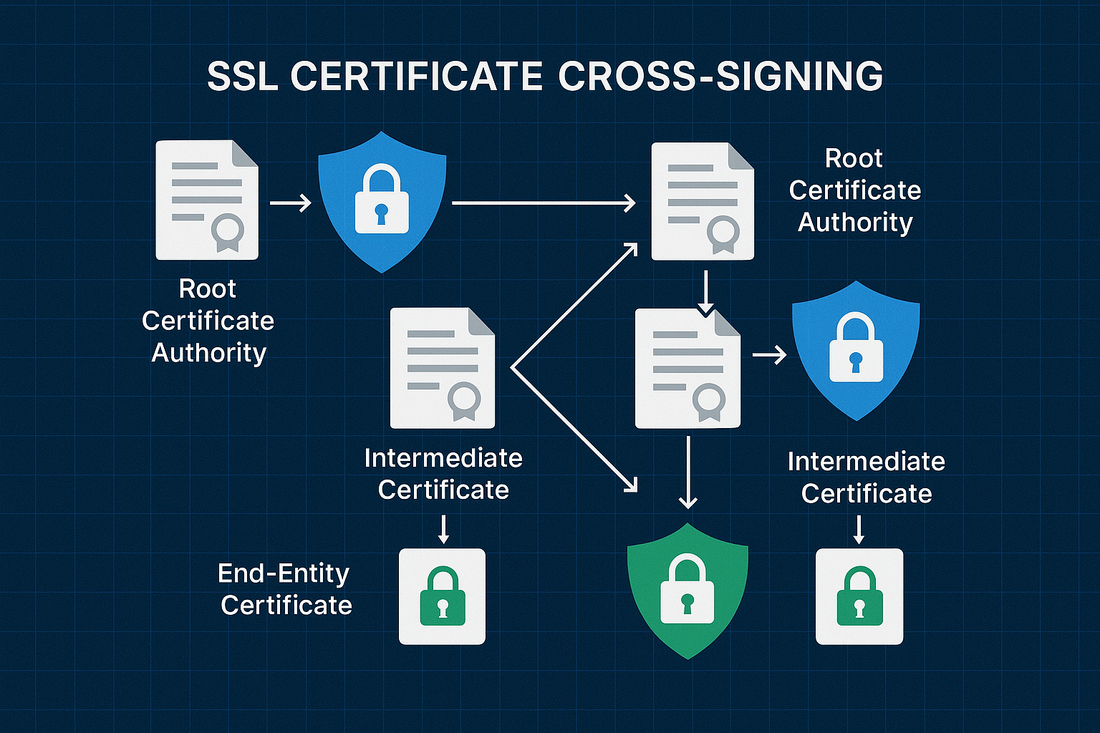
Understanding SSL Certificate Cross-Signing
Emma ThompsonShare
SSL Certificate cross-signing represents one of the most sophisticated aspects of Public Key Infrastructure (PKI) management, enabling Certificate Authorities (CAs) to extend trust relationships and ensure seamless SSL Certificate validation across diverse environments.
At Trustico® we understand the critical importance of proper cross-signing implementation for maintaining robust SSL Certificate security and compatibility. This guide explores the intricacies of SSL Certificate cross-signing, providing essential insights for organizations seeking to optimize their SSL Certificate management strategies.
Cross-signing occurs when one Certificate Authority (CA) digitally signs another Certificate Authority (CA) intermediate SSL Certificate, creating a trust bridge between different PKI hierarchies. This process enables SSL Certificates issued by one CA to be validated through multiple trust paths, significantly enhancing compatibility and reducing potential validation failures.
Trustico® SSL Certificates leverage advanced cross-signing techniques to ensure maximum browser and device compatibility across all deployment scenarios.
The Technical Foundation of SSL Certificate Cross-Signing
SSL Certificate cross-signing operates through the creation of multiple SSL Certificate chains, each providing an alternative validation path to a trusted root Certificate Authority (CA).
When a Certificate Authority (CA) cross-signs another CA intermediate SSL Certificate, it creates a parallel trust hierarchy that browsers and applications can utilize for SSL Certificate validation. This redundancy proves invaluable when dealing with legacy systems, diverse client environments, or transitional periods between Certificate Authority (CA) migrations.
The cross-signing process involves the signing Certificate Authority (CA) using its private key to create a digital signature over the target intermediate SSL Certificate. This signature establishes cryptographic proof that the signing CA vouches for the authenticity and trustworthiness of the cross-signed intermediate. Trustico® SSL Certificates benefit from sophisticated cross-signing arrangements with Sectigo® branded SSL Certificates and their cross-signing arrangements, ensuring comprehensive trust coverage across all major platforms and devices.
Understanding the SSL Certificate chain validation process becomes crucial when implementing cross-signed SSL Certificates. During SSL handshake negotiations, clients receive the server SSL Certificate along with any intermediate SSL Certificates required to build a complete trust chain to a root Certificate Authority (CA).
With cross-signed SSL Certificates, multiple valid chains may exist, and clients will typically select the chain that terminates at a root CA they recognize and trust.
Benefits and Advantages of Cross-Signed SSL Certificates
Cross-signing provides numerous strategic advantages for organizations implementing SSL Certificates across diverse infrastructure environments.
Enhanced compatibility represents the primary benefit, as cross-signed SSL Certificates can validate successfully across a broader range of browsers, operating systems, and applications. This compatibility proves especially valuable for organizations serving global audiences with varying technological capabilities and legacy system requirements.
Trustico® SSL Certificates utilize cross-signing to maximize compatibility with older browsers and embedded systems that may not recognize newer Certificate Authority (CA) roots.
By maintaining cross-signatures with established, widely-trusted root SSL Certificates, our SSL Certificates ensure seamless operation across the entire spectrum of client environments. This approach eliminates SSL Certificate validation errors that could otherwise impact user experience and business operations.
Risk mitigation represents another significant advantage of cross-signed SSL Certificates. When Certificate Authorities (CAs) implement cross-signing strategies, they create redundant trust paths that provide fallback options in case of root SSL Certificate issues, revocations, or trust store modifications.
Organizations deploying Trustico® SSL Certificates benefit from this enhanced resilience, as our cross-signing partnerships ensure continued SSL Certificate validation even during Certificate Authority (CA) transitions or trust store updates.
Common Cross-Signing Implementation Challenges
Despite their advantages, cross-signed SSL Certificates can present implementation challenges that require careful consideration and expert guidance.
SSL Certificate chain ordering issues frequently arise when servers present SSL Certificate chains in incorrect sequences, potentially causing validation failures in certain client environments. Proper SSL Certificate chain construction requires presenting SSL Certificates in the correct hierarchical order, from the end-entity SSL Certificate through all necessary intermediates to the root Certificate Authority (CA).
Legacy system compatibility can create additional complexity when implementing cross-signed SSL Certificates. Older applications and embedded systems may have limited SSL Certificate chain processing capabilities, requiring specific SSL Certificate chain configurations to ensure successful validation.
Trustico® SSL Certificates address these challenges through comprehensive testing and validation across diverse platform environments, ensuring optimal compatibility with both modern and legacy systems.
SSL Certificate bundle management becomes increasingly complex with cross-signed SSL Certificates, as administrators must maintain awareness of multiple potential SSL Certificate chains and their respective validation requirements.
Proper documentation and configuration management practices become essential for maintaining consistent SSL Certificate deployment across distributed infrastructure environments. Our support team assists customers in navigating these complexities, providing detailed guidance for optimal cross-signed SSL Certificate implementation.
Sectigo® Branded SSL Certificates and Cross-Signing Excellence
Sectigo® branded SSL Certificates available through Trustico® demonstrate industry-leading cross-signing capabilities, leveraging extensive Certificate Authority (CA) partnerships to ensure maximum compatibility and trust coverage.
These SSL Certificates benefit from sophisticated cross-signing arrangements that provide multiple validation paths, enhancing reliability and reducing the risk of SSL Certificate validation failures across diverse client environments.
The Sectigo® Certificate Authority (CA) maintains strategic cross-signing relationships with established root Certificate Authorities (CAs), enabling seamless SSL Certificate validation across virtually all browsers, operating systems, and applications. This comprehensive trust coverage ensures that organizations deploying Sectigo® branded SSL Certificates through Trustico® can confidently serve global audiences without concerns about SSL Certificate compatibility or validation issues.
Advanced SSL Certificate lifecycle management features integrated into Sectigo® branded SSL Certificates simplify cross-signing implementation and maintenance.
Automated SSL Certificate chain optimization ensures that servers present the most appropriate SSL Certificate chain for each client environment, maximizing compatibility while minimizing SSL Certificate bundle complexity.
These intelligent features reduce administrative overhead while maintaining optimal SSL Certificate performance across all deployment scenarios.
Cross-Signing Best Practices and Implementation Guidelines
Successful SSL Certificate cross-signing implementation requires adherence to established best practices and careful attention to configuration details.
SSL Certificate chain validation testing should be performed across multiple browser and platform combinations to ensure consistent behavior and identify potential compatibility issues.
Proper SSL Certificate bundle construction represents a critical success factor for cross-signed SSL Certificates. Server configurations must present complete SSL Certificate chains that include all necessary intermediate SSL Certificates, arranged in the correct hierarchical order. Incomplete or incorrectly ordered SSL Certificate chains can cause validation failures even when valid cross-signing relationships exist. Our technical support team provides detailed configuration guidance to ensure optimal SSL Certificate chain presentation.
Monitoring and maintenance procedures should account for the increased complexity of cross-signed SSL Certificate environments. Regular validation testing across diverse client environments helps identify potential issues before they impact production systems.
SSL Certificate expiration monitoring becomes more complex with cross-signed SSL Certificates, as multiple SSL Certificate chains may have different expiration schedules requiring coordinated renewal planning, however, this is something that Trustico® mitigates with our Certificate Authority (CA) relationships and subsequent processes.
Troubleshooting Cross-Signed SSL Certificate Issues
When SSL Certificate validation issues arise in cross-signed environments, systematic troubleshooting approaches help identify and resolve problems efficiently.
SSL Certificate chain analysis tools can examine the complete SSL Certificate hierarchy and identify potential issues with SSL Certificate ordering, missing intermediates, or invalid cross-signatures.
OpenSSL command-line tools provide valuable diagnostic capabilities for analyzing SSL Certificate chains and validation paths.
Browser-specific validation behavior can vary significantly with cross-signed SSL Certificates, requiring testing across multiple client environments to identify compatibility issues.
Some browsers may prefer certain SSL Certificate chains over others, while legacy applications might have specific requirements for SSL Certificate chain construction.
Trustico® SSL Certificates undergo extensive compatibility testing to minimize these variations and ensure consistent behavior across all major platforms.
Certificate Authority (CA) trust store changes can impact cross-signed SSL Certificate validation, particularly when root SSL Certificates are added, removed, or modified in client trust stores.
Staying informed about trust store updates and their potential impact on SSL Certificate validation helps organizations proactively address compatibility issues. Our support team monitors Certificate Authority (CA) trust store changes and provides timely guidance on their implications for deployed SSL Certificates.
Future Trends in SSL Certificate Cross-Signing
The evolution of SSL Certificate cross-signing continues to adapt to changing technological landscapes and security requirements.
SSL Certificate Transparency initiatives are influencing cross-signing practices, as Certificate Authorities (CAs) must ensure that all SSL Certificate chains, including cross-signed variants, are properly logged and monitored. Trustico® SSL Certificates fully support SSL Certificate Transparency requirements, ensuring compliance with emerging transparency standards.
Post-quantum cryptography preparations are beginning to influence cross-signing strategies, as Certificate Authorities (CAs) plan for the eventual transition to quantum-resistant algorithms.
Cross-signing may play a crucial role in managing the migration from current cryptographic standards to post-quantum alternatives, providing compatibility bridges during the transition period. Our forward-looking approach ensures that Trustico® SSL Certificates will support emerging cryptographic standards while maintaining backward compatibility.
Automated SSL Certificate management systems are increasingly incorporating cross-signing awareness, enabling intelligent SSL Certificate chain selection based on client environment characteristics. These advanced systems can dynamically optimize SSL Certificate presentation for maximum compatibility while minimizing administrative overhead.
Choosing Trustico® SSL Certificates for Cross-Signing Excellence
Organizations seeking optimal SSL Certificate cross-signing capabilities should consider the comprehensive advantages offered by Trustico® SSL Certificates.
Our extensive portfolio includes both Trustico® branded and Sectigo® branded SSL Certificates, each designed to provide maximum compatibility and reliability through sophisticated cross-signing implementations.
Expert support and guidance ensure successful deployment and ongoing management of cross-signed SSL Certificate environments.
The combination of technical excellence, comprehensive compatibility testing, and expert support makes Trustico® SSL Certificates the ideal choice for organizations requiring robust cross-signing capabilities.
Whether deploying Domain Validation (DV), Organization Validation (OV), or Extended Validation (EV) SSL Certificates, our solutions provide the cross-signing features necessary for optimal performance across diverse client environments.
Contact our expert team today to learn how Trustico® SSL Certificates can enhance your organization security posture through advanced cross-signing implementation.



